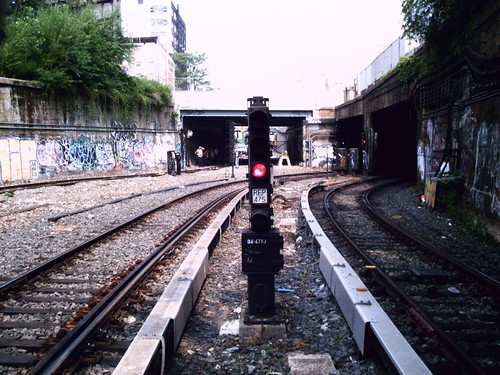The MTA will soon be replacing all of the signals in the subway system. (Photo courtesy of flickr user larryosan)
So let’s talk signals. You, the daily subway rider, know them more as an annoyance than as anything else. Earlier this week, those pesky signals at 59th Street caused massive delays up and down the IND lines.
Like much of the subway system, the signals are aging, and the MTA is looking to replace them while jumping on the ever-popular green bandwagon. After six years of development working along side Dialight, the worldwide leader in LED technology, the MTA is ready to get moving on this project. This week, the MTA awarded Dialight a $1.8 million contract to retrofit the subway signals. LEDs Magazine – seriously, they have industry publications for everything — has more:
Dialight Corporation has been awarded a $1.8 million contract to provide LED trackside signals for the New York City subway system. The contract calls for retrofitting 13,400 incandescent units with LED modules, thereby completing conversion of all of the system’s more than 50,000 signals.
The LED signals are saving the city nearly $1 million a year in utility bills and maintenance. They are designed to retrofit two 16-watt incandescent bulbs with a robust module based on the latest high-flux LED and driver technology. With a projected service life of 10 years, the LED modules provide energy savings of 85 percent.
So the MTA is saving money and contributing to the drive toward an energy-efficient society. Is everyone at MTAHQ feeling ok? (Just kidding, guys.)
The Dialight folks praised themselves for the new LED lights. “The new signals are being well received by the city’s transit workers, who have indicated they are performing extremely well, and that the saturated colors of the LEDs are much more visible, resulting in greater safety on the tracks,” Business Development Manager Laura Hoffmann said.
While I like what I’m hearing — lights that are easier to see, greater track safety, saving money through energy efficiency — I can’t help but wonder how the city plans on replaces 13,400 lightbulbs. I’m going to have to go with weekend service delays and more irate passengers. But it will all pay off in the long run. The lights at the end of the tunnel will be brighter.


4 comments
Instead of just replacing the signals, umm make room for automatic receivers & broadcasters so we can make the subway automatic. In turn make the subway faster.
All they are doing is essentially replacing the light bulbs. Whatever actually causes the signals to work (all of the controllers, sensors, wiring) will still be just as lousy as its been before. Trust me, this isn’t the cure for “signal problems”.
Well bulb replacements once they go to LEDs shouldn’t be a big deal. One of the benefits of LED lighting is an extremely long lifespan. I’m guessing these bulbs will shine bright for at least 10 years without replacements and likely much longer.
“Instead of just replacing the signals, umm make room for automatic receivers & broadcasters so we can make the subway automatic. In turn make the subway faster.”
Driverless trains? It’s called OPTO and it’s been shown to be a disaster waiting to happen. Take a look at this safety drill in which one train operator tried to stage an evacuation of a partially-full train:
http://webdocs.nyccouncil.info.....N=95450787
Imagine this as a real emergency on a rush-hour train, with 1000+ passengers being evacuated by a single MTA worker.
I’ll take full staffing on my train, thank you very much.